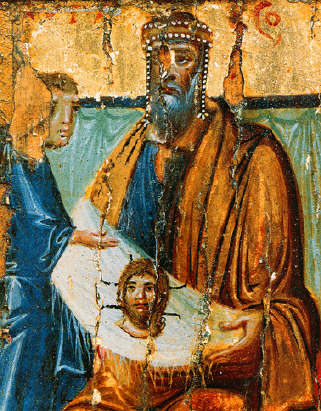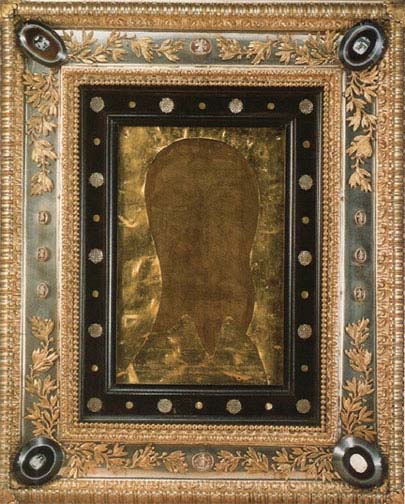Here is part 7, "The Image of Edessa" (3), of my critique of historian Charles Freeman's, "The Turin Shroud and the Image of Edessa: A Misguided Journey," May 24, 2012 [pages 6-7]. See previous part 6.
[Above (click to enlarge): "The Holy Towel of Jesus," also known as "The Holy Face of San Silvestro," a copy of the Mandylion or Image of Edessa (the Shroud of Turin folded eight times with Jesus' head only visible in landscape aspect), is normally kept at the Pope's private chapel in the Vatican: "Is this a true portrait of Christ?," Daily Mail, 6 April 2011. Freeman mentions this below as part of the British Museum's "Treasures of Heaven" exhibition, 23 June–9 October 2011.]
This is one of at least six very similar "Holy Faces," including  the "Holy Face of Genoa"
the "Holy Face of Genoa"
[Left (enlarge): "The Holy Face of Genoa," preserved in the Church of St Bartholomew of the Armenians, Genoa: Wikipedia]
and the "Holy Face of Vienna."
[Below right (click to enlarge): the "Holy Face of Vienna": Facsimile Copy of the Veronica made in 1617. The Hofburg palace, Vienna: Wikipedia]
All six are thought to be copies of the Vatican's "Veil of Veronica", which has become so faded that its image is nearly invisible.
While these "veils" may be ultimately based on the Image of Edessa, their apparent stylistic conformity to a woman's veil means they are not a good example to demonstrate that the Image of Edessa is actually the Shroud of Turin, "four-doubled" (Greek: tetradiplon). Which presumably is why Freeman cited it, as part of his "misguided" attempt to convince his readers that both the Image of Edessa and the Shroud of Turin are two separate, and fake, relics!
Freeman continues with another falsehood, that "The Image of Edessa shows the face of a bearded ... Christ set in the middle of a square cloth":
The Image of Edessa shows the face of a bearded and, of course, living, Christ set in the middle of a square cloth. It is known from many copies. There is no body shown under the face and the cloth is often shown with a border. A good example is one of the panels of the Santa Chiara triptych (c. 1330-50) in the Sartario Museum in Trieste where red tassels surround the borders. It is illustrated below – apologies for quality of the enlargement but it shows the head of Christ, his halo, the red borders of the cloth and the lack of any body. One instantly knows that this is the Image/ Mandylion precisely because only the face is shown and the whole cloth is shown delineated. An excellent early example of a copy of the Mandylion, from the Vatican, was to be seen in the British Museum Treasures of Heaven exhibition of 2011 (catalogue entry no.113). There is an excellent discussion of the Mandylion with illustrations in Chapter 11 of Hans Belting's Likeness and Presence, pp. 208-224.
That in fact the Image of Edessa shows Jesus' face set in the middle of, not a "square" cloth but a rectangular cloth, is evident from
 [Above: (click to enlarge): Tenth century icon depicting Edessa's King Abgar V (c. 4 BC-AD 50), holding the rectangular Image of Edessa or Mandylion, with Jesus' face in unusual (if not unique in all of art), for a portrait, in landscape aspect: Wikipedia]
[Above: (click to enlarge): Tenth century icon depicting Edessa's King Abgar V (c. 4 BC-AD 50), holding the rectangular Image of Edessa or Mandylion, with Jesus' face in unusual (if not unique in all of art), for a portrait, in landscape aspect: Wikipedia]
Wikipedia's "Image of Edessa" page (above). See also the rectangular Sakli Church Image of Edessa in part 6. This rectangular versus square issue is very important as we shall see.
As for Freeman's "good example" (so-called) of the Image of Edessa, in "one of the panels of the Santa Chiara triptych (c. 1330-50) in the Sartario Museum in Trieste," that he had to `scrape the

A copy, one of many of the Image of Edessa, the Mandylion. Shown as one panel on a large triptych. Venetian/ Byzantine art, c. 1330-50. Note how the border of the cloth is clearly shown.]
bottom of the barrel' to find a square Image of Edessa is evident in that all he could find is this blurry photo of one, and he even gives "apologies for quality of the enlargement"! Freeman does not consider that the reason this rare Mandylion is square, is because it is a "panel" and so its shape is determined by its functional context.
But if he had tried harder (i.e. Googling "Santa Chiara" and "Mandylion"), Freeman could have found a clearer example of this Mandylion copy (see below).

[Left (click to enlarge): "Holy Face, part Triptych of St. Clare, 1310 the middle 1330 side panels, Trieste, Civico Museo Sartorio. The altarpiece panel can be assigned to a teacher near the Byzantine style and miniature (recognized in Marco Veneziano or Master of Santa Chiara). The Face represented as Mandylion is positioned between episodes of the Passion (Road to Calvary and the Crucifixion)": Veronica Route (Translated from Italian by Google)]
But perhaps the real reason Freeman only allowed his readers to see a blurry photograph of this copy of the Image of Edessa is because it reveals at least eight "Vignon Markings": wisps of hair  representing the reversed 3 bloodstain (no. 15);
representing the reversed 3 bloodstain (no. 15);
[Left (click to enlarge): The 15 "Vignon Markings" all found on the Shroud of Turin: Wilson, I., "The Turin Shroud," 1978, p.82e]
line across the forehead (no. 1); topless square above nose (no. 2); eyes wide and staring (no. 14); vertical line between nose and upper lip (no. 9); heavy line under lower lip (no. 10); hairless area between lower lip and beard (no. 11) and forked beard (no. 12). These are all found on the Shroud and so alone refute Freeman's argument that the Image of Edessa and the Shroud of Turin are not one and the same.
Freeman continues:
After it was `revealed' in its walled-up enclosure (miraculously surviving centuries of damp!) the Image of Edessa became open to intense veneration. In 787 Leo, Reader of Constantinople reported that he had seen in Edessa `the holy image that was "not made by human hands", held in honour and venerated by the faithful'. Hans Belting quotes (p.211) a report that the faithful actually sprinkled its eyes with water. For reasons that completely escape me, Wilson claims that the Image of Edessa is none other than the Shroud of Turin.
As for his "miraculously surviving centuries of damp," Freeman fails to tell his readers that Wilson, in his latest book (which Freeman implies he has read) specifically states that the Shroud's hiding place "above the city gate" was "sealed up with mortar" and so would "have enjoyed near hermetically sealed conditions":
"According to the ... information [in the Story of the Image of Edessa] ... was hidden away above the city gate ... in a place... shaped like a cylindrical semi-circle ... the gateway's brickwork ... sealed up with mortar ... would certainly have enjoyed near hermetically sealed conditions throughout" Wilson, I., "The Shroud," 2010, pp.131-133).
As stated in part 6, for other reasons I prefer Markwardt's theory (see his "Antioch and the Shroud" [PDF]) that the Shroud was in Antioch from c.47-526, after which it was taken to Edessa and the Edessans retrospectively applied the true history of the Shroud in Antioch to Edessa. Nevertheless ancient linen cloths have survived far longer in worse conditions than the 468 years (c.57-525) that Wilson's theory proposes that the Shroud was near-hermetically sealed up in Edessa's wall.
As for Freeman's, "In 787 Leo, Reader of Constantinople, reported that he had seen in Edessa `the holy image that was "not made by human hands", held in honour and venerated by the faithful'," this is an argument for Wilson's theory! Indeed, it is quoted by Wilson as such:
"Certainly in 787, a certain Leo the Reader of Constantinople when he visited Edessa was able to report, 'When I, your unworthy servant, went to Syria with the royal commission, I came to Edessa and saw the holy image that was not made by human hands, held in honour and venerated by the faithful.' [Mansi, in Guscin, M., "The Image of Edessa," 2009, p.179]." (Wilson, I., "The Shroud," 2010, p.154).
Art historian Hans Belting's "report that the faithful actually sprinkled its eyes with water" can be read online and may be seen to be anonymous, vague, and not contemporaneous:
"The rituals of the feast of the cloth image in Edessa are described retrospectively by a writer apparently a court theologian, from Byzantium, who adorns them with mystagogic explanations. The relic, concealed behind a white or purple cover, was usually kept in a shrine and was set up on a `throne' only on special days. On feast days it was approached with water that the people sprinkled on its eyes." (Belting, H., "Likeness and Presence," Chicago, 1994, p.211).
This sounds like one of those "mystagogic explanations"! It is highly unlikely (to put it mildly) that the Byzantine clergy would have let the common people get anywhere near close enough to their holiest relic for them to be able to sprinkle water on its eyes, let alone allow them to do it. There is more in the next part on this.
Freeman's "For reasons that completely escape me, Wilson claims that the Image of Edessa is none other than the Shroud of Turin," is an "Argument from Ignorance" ("I cannot understand this, therefore it cannot be true") by Freeman, if not an "Argument from Personal Incredulity" ("I cannot believe this, therefore it cannot be true"). That it completely escapes Freeman the reasons why Wilson claims that the Image of Edessa is the Shroud of Turin (apart from it being an damaging admission for a scholar to make, that he cannot understand the position he is criticising), is no reason why the Image of Edessa cannot be the Shroud of Turin!
Continued in part 8: "The Image of Edessa" (4)
Posted 3 September 2012. Updated 1 September 2025.






No comments:
Post a Comment